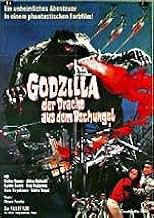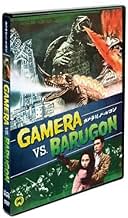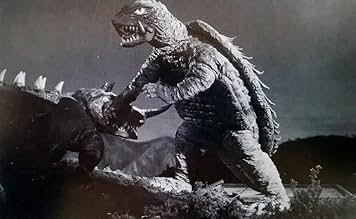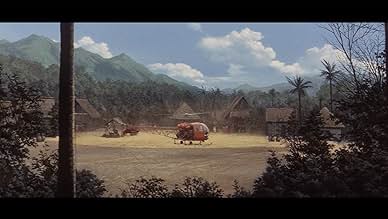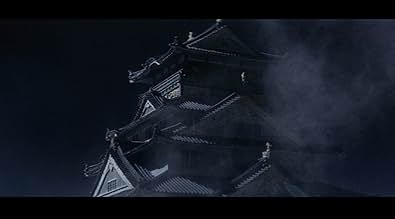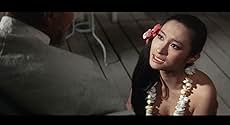NOTE IMDb
5,1/10
3 k
MA NOTE
Ajouter une intrigue dans votre langueA giant monster that emits a destructive ray from its back attacks Japan and takes on Gamera.A giant monster that emits a destructive ray from its back attacks Japan and takes on Gamera.A giant monster that emits a destructive ray from its back attacks Japan and takes on Gamera.
- Réalisation
- Scénario
- Casting principal
Jutarô Kitashiro
- Self-Defense Force Commander
- (as Jutarô Hôjô)
Avis à la une
I have to agree with the first comment and say that this is the best of pre-1995 the Gamera's. I've seen five of them, Guiron and Zigra both being indescribably bad (even when I watched them as a 13 year old I thought so). This one is honestly pretty good, a step-up from the stone age-looking Gamera, which was made in 1965 but looked like it was made in 1954! First off, there isn't too much flashback footage and when it is used, it's actually well-edited and has some pretty cool narration and atmospheric music. There's a random dam attack scene which I still cant figure out why it's there, and then the real story starts with the protagonists finding a jewel that eventually turns into the secondary monster.
Gamera plays a pretty minor second-fiddle this time around, with Barugon, an admittedly more interesting monster, hogging most of the screentime destroying things. I really liked the plotting with the greedy guy accidentally waking the monster with his heat-lamp, and then getting eaten when he ruins the army's plan by trying to steal a giant diamond.
This has the best music and best scenes of destruction of any of the Gamera movies and most of Jun Fukuda's Godzilla films. While it's still Daiei, which most of the time is sub-Toho in every respect, this film shows that around 1966 Daiei actually managed to surpass Toho every now and then effects-wise. Good directing too: the tone is surprisingly mature this time around and it's got a really dark and humorless undercurrent to the whole thing.
My favorite Gamera movie, followed by the... so unintentionally hilarious, it makes me crack up thinking about it... Gamera vs. Gaos.
Gamera plays a pretty minor second-fiddle this time around, with Barugon, an admittedly more interesting monster, hogging most of the screentime destroying things. I really liked the plotting with the greedy guy accidentally waking the monster with his heat-lamp, and then getting eaten when he ruins the army's plan by trying to steal a giant diamond.
This has the best music and best scenes of destruction of any of the Gamera movies and most of Jun Fukuda's Godzilla films. While it's still Daiei, which most of the time is sub-Toho in every respect, this film shows that around 1966 Daiei actually managed to surpass Toho every now and then effects-wise. Good directing too: the tone is surprisingly mature this time around and it's got a really dark and humorless undercurrent to the whole thing.
My favorite Gamera movie, followed by the... so unintentionally hilarious, it makes me crack up thinking about it... Gamera vs. Gaos.
Shigeo Tanaka directed "Gamera vs. Barugon" in 1966, the second film to feature the giant fire-breathing turtle Gamera. I'll be the first to give "Gamera vs. Barugon" a fair review. This second entry into the original seven-film series is probably my favorite, simply because it doesn't feature any annoying Gamera friends; you know what I mean, kids. "Gamera vs. Barugon" is the only movie in the series to not feature annoying adolescents who can communicate with the monster. In this second feature, greedy fortune hunters head to New Guinea where they believe a priceless opal was hidden during the Second World War. Alas, they find it, but one of them is greedier than the other two and kills them both off (well, one of them is stung by a poisonous scorpion, and the other, the hero of the story, survives the attempted assassination). What the greedy man doesn't know, is that what he has in his possession is not a jewel at all, but a monster's egg, Barugon's egg. The infant monster, once exposed to infra-red heat rays, grows to its mature size and begins attacking Japan. Gamera interferes but is defeated quite easily by Barugon's freezing vapor. Meanwhile, the hero and a village girl travel back to Japan, using the ancient legends (combined with modern scientific technology) to try to defeat Barugon once and for all. When these plans fail miserably, it appears that only Gamera stands a chance of bringing Barugon's reign of terror upon Japan to an end. I'll understand this film's low rating, but believe me, as a Gamera fan (and Godzilla too), this is probably the best film in the series. Gamera is off-screen for the most part, and the new monster Barugon takes center stage laying waste to Japan. Forget the bad dubbing for once, too. The musical score is pretty exotic and atmospheric, almost comparable to anything featured in the "Godzilla" series of films. Still, for a movie that was made in '66, the effects hold up surprisingly well, even if it is easy to find the many faults with them. Believe it or not, I actually like the older kaiju films much rather than their special-effects/CGI-laden, modern-day counterparts. For these reasons, "Gamera vs. Barugon" gets a five out of 10 from me.
5/10
5/10
If you're a fan of Gamera from '90s trilogy, Gamera vs. Barugon may be the original Gamera movie for you.
The movie begins with Gamera's being freed from the rocket he was trapped in at the end of Gamera, the Gigantic Monster and returning to Earth to wreak havoc on a dam. He then disappears for a good 45 minutes while the movie follows a trio of treasure hunters to a tropical island on their quest to retrieve an opal the brother of one of the hunters hid in a cave during the Second World War. Not to give away too much, but the procurement of this opal leads to the emergence of Barugon, in the middle of Japan, who Gamera (eventually) fights in typical Gamera fashion.
Three things immediately stand out about the second entry in the Gamera series:
There are no kids in this movie. As in its predecessor, Gamera is apparently motivated purely by a quest for energy sources.
Gamera is barely in the movie. He opens the movie, returns to fight Barugon, then comes back after another long absence to fight Barugon again. The bulk of the movie deals with the birth of Barugon and the Japanese's attempts to defeat him. (Maybe this was the genesis of the military's conflict in Gamera: The Revenge of Iris over which monster to attack first.)
Finally, the movie is in color, and Daiei seems eager to exploit that fact. The opening titles are played out over shapeless colors, and one of Barugon's weapons is a rainbow beam emanating from his back.
The movie contains some silly moments (most notably the theft of the diamond), but the human conflicts and relationships are played surprisingly straight and adult, at least in comparison to those in a typical Godzilla movie; everyone doesn't necessarily agree on strategy, and it's probably safe to say the two leads don't view each other as siblings. The biggest problem with the movie is its odd pacing, but without a delusional kid and several characters who do virtually nothing running around, Gamera vs. Barugon is a decided improvement over the original.
The movie begins with Gamera's being freed from the rocket he was trapped in at the end of Gamera, the Gigantic Monster and returning to Earth to wreak havoc on a dam. He then disappears for a good 45 minutes while the movie follows a trio of treasure hunters to a tropical island on their quest to retrieve an opal the brother of one of the hunters hid in a cave during the Second World War. Not to give away too much, but the procurement of this opal leads to the emergence of Barugon, in the middle of Japan, who Gamera (eventually) fights in typical Gamera fashion.
Three things immediately stand out about the second entry in the Gamera series:
There are no kids in this movie. As in its predecessor, Gamera is apparently motivated purely by a quest for energy sources.
Gamera is barely in the movie. He opens the movie, returns to fight Barugon, then comes back after another long absence to fight Barugon again. The bulk of the movie deals with the birth of Barugon and the Japanese's attempts to defeat him. (Maybe this was the genesis of the military's conflict in Gamera: The Revenge of Iris over which monster to attack first.)
Finally, the movie is in color, and Daiei seems eager to exploit that fact. The opening titles are played out over shapeless colors, and one of Barugon's weapons is a rainbow beam emanating from his back.
The movie contains some silly moments (most notably the theft of the diamond), but the human conflicts and relationships are played surprisingly straight and adult, at least in comparison to those in a typical Godzilla movie; everyone doesn't necessarily agree on strategy, and it's probably safe to say the two leads don't view each other as siblings. The biggest problem with the movie is its odd pacing, but without a delusional kid and several characters who do virtually nothing running around, Gamera vs. Barugon is a decided improvement over the original.
This used to be my least favorite of the original Gamera series but I watched it recently (minus the Joel and bots comments, since I have the old MST3K episode on tape) and I was really surprised with the special effects. The opening scene where Gamera (the narrator butchers his name too) attacks the damn was well done. There are a lot of cool miniatures and as it has been mentioned several times already- this movie is 'kenny' free.
Sadly, there really isn't a lot going on in this film. I do like the overall weirdness of it all: a giant flying turtle battling against a creature who attacks people with his tongue and a rainbow! Hey, it was the 60s ... what can I say? Sady Franks either had a brainstorming session or they were high when they made these movies.
There's actually a coherent plot to this movie and I suppose Gamera changes from a baddie to a good guy in this one. They just really stretch everything so thin and there aren't enough monster fight scenes to make me happy. I'm being really generous with rating this ...
Sadly, there really isn't a lot going on in this film. I do like the overall weirdness of it all: a giant flying turtle battling against a creature who attacks people with his tongue and a rainbow! Hey, it was the 60s ... what can I say? Sady Franks either had a brainstorming session or they were high when they made these movies.
There's actually a coherent plot to this movie and I suppose Gamera changes from a baddie to a good guy in this one. They just really stretch everything so thin and there aren't enough monster fight scenes to make me happy. I'm being really generous with rating this ...
This probably is the most adult oriented of all the Gamera films mainly because it is the only film in the original series not to feature a child as the main human character. However, I also think that it is the one of the weaker films in the series. The human characters aren't really that interesting and this is one of the flaws of the Gamera series. At least with the Godzilla series (or for that matter Toho kaiju films altogether) the human characters, especially in the earlier films, are fully dimensional whereas in the Gamera films they are treated as more of an afterthought. This film is not really one of the brighter moments in the whole Gamera series.
Le saviez-vous
- AnecdotesThis is the only film in the original series to not feature a child as the main human character.
- GaffesEnglish language version: If Barugon's is harmed by water, how did he swim from the sunken ship to the shore without any difficulty? The translation neglects to mention that while he's vulnerable to water, it doesn't immediately kill him, just weakens him. It has also been suggested that salt water doesn't harm him as much as fresh water.
- Versions alternativesThe Japanese version runs a complete 101 minutes. The American International Pictures-TV (A.I.P.-TV) release version, under the title WAR OF THE MONSTERS, was cut down to 88 minutes to fit it's televised playdates. The 14 minutes that were removed were only expository scenes that had the characters discuss how to destroy the monster Barugon.
- ConnexionsFeatured in Gamera contre Viras (1968)
Meilleurs choix
Connectez-vous pour évaluer et suivre la liste de favoris afin de recevoir des recommandations personnalisées
Détails
- Durée1 heure 46 minutes
- Mixage
- Rapport de forme
- 2.35 : 1
Contribuer à cette page
Suggérer une modification ou ajouter du contenu manquant

Lacune principale
By what name was Gamera contre Barugon (1966) officially released in India in English?
Répondre
